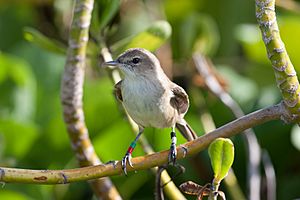Nihoa millerbird facts for kids
Quick facts for kids Nihoa millerbird |
|
|---|---|
 |
|
| On the island of Nihoa, Northwestern Hawaiian Islands | |
| Conservation status | |
| Scientific classification |
|
| Kingdom: | Animalia |
| Phylum: | Chordata |
| Class: | Aves |
| Order: | Passeriformes |
| Family: | Acrocephalidae |
| Genus: | Acrocephalus |
| Species: | |
| Subspecies: |
A. f. kingi
|
| Trinomial name | |
| Acrocephalus familiaris kingi (Wetmore, 1923)
|
|
The Nihoa millerbird (Acrocephalus familiaris kingi) is a small songbird. It is a special type, or subspecies, of the millerbird. This bird gets its name because it loves to eat Miller moths.
The Nihoa millerbird is about 5-inch (13 cm) long. It has dark, sepia-colored feathers and a white belly. Its beak is also dark. This bird lives only on the tiny island of Nihoa. Nihoa is part of the Northwestern Hawaiian Islands.
Scientists hope that moving some birds to Laysan island will help them survive. The Nihoa millerbird is one of only two birds that live only on Nihoa. The other is the Nihoa finch.
There are only about 200 to 900 Nihoa millerbirds left. This makes them seriously endangered. They are always at risk of disappearing forever. Things like droughts, fires, or too many insects can harm them. They cannot fly away from the island to escape danger. The Laysan millerbird was a close relative, but it is now extinct.
The bird's scientific name, kingi, honors Samuel Wilder King. He was the captain of the Tanager Expedition. Later, he became the Governor of Hawaii.
Contents
Protecting the Nihoa Millerbird

People have worked hard to protect the Nihoa millerbird. In September 2011, 24 birds were moved by ship. They traveled about 650 miles (1,050 km) from Nihoa to Laysan island. The goal was to start a new group of millerbirds on Laysan. This would help keep the species safe.
A student named Mark MacDonald led a team of researchers. They gathered information to help with the move. From July to September 2007, his team caught and banded Nihoa millerbirds. They measured the birds and checked their health. They also watched what the birds ate.
The team studied insects on both Nihoa and Laysan. This helped them find out what food would be available for the birds. MacDonald's study found about 800 millerbirds on Nihoa. This was a good number compared to past years.
How Scientists Studied the Birds
Scientists used special nets called mist nets to catch 85 millerbirds. Each bird was given colored leg bands. These bands help scientists identify each bird later. This way, they can track birds without catching them again.
The bands also help biologists find pairs of birds. They can map their territories and see how long individual birds live. The team took photos and measurements of the birds' feathers. They also took small feather samples for genetic tests.
Growth lines on tail feathers can show a bird's age. Comparing photos and measurements helps scientists tell if a bird is male or female. Knowing this helps them move the right number of males and females to Laysan.
What Millerbirds Like to Eat
Some Nihoa millerbirds were placed in a temporary cage. Scientists offered them different island insects. This helped them learn what the birds liked to eat. It also showed if the birds would eat in captivity.
The birds ate well from a plastic container of insects. They did not eat ladybugs, sow-bugs, or ants. One bird quickly chased cockroaches. Then it ate smaller, slower insects like spiders and beetles. Another test showed that a male and female pair ate together easily.
Listening to Millerbird Songs
The team used an iPod and a speaker to play millerbird songs. They played the songs in the territories of 60 male birds. They recorded the birds' responses with a microphone. These recordings helped them map the territories of 20 males.
Scientists will also study the recordings to see if millerbird songs are different across Nihoa. Early studies show some differences in male millerbird songs. More research is needed to see if these differences are important. Finding different "dialects" of songs on such a small island would be a big discovery.
Thanks to the hard work of MacDonald and his team, the Nihoa millerbird has a better chance to survive. Establishing a second population greatly reduces the risk of extinction.


